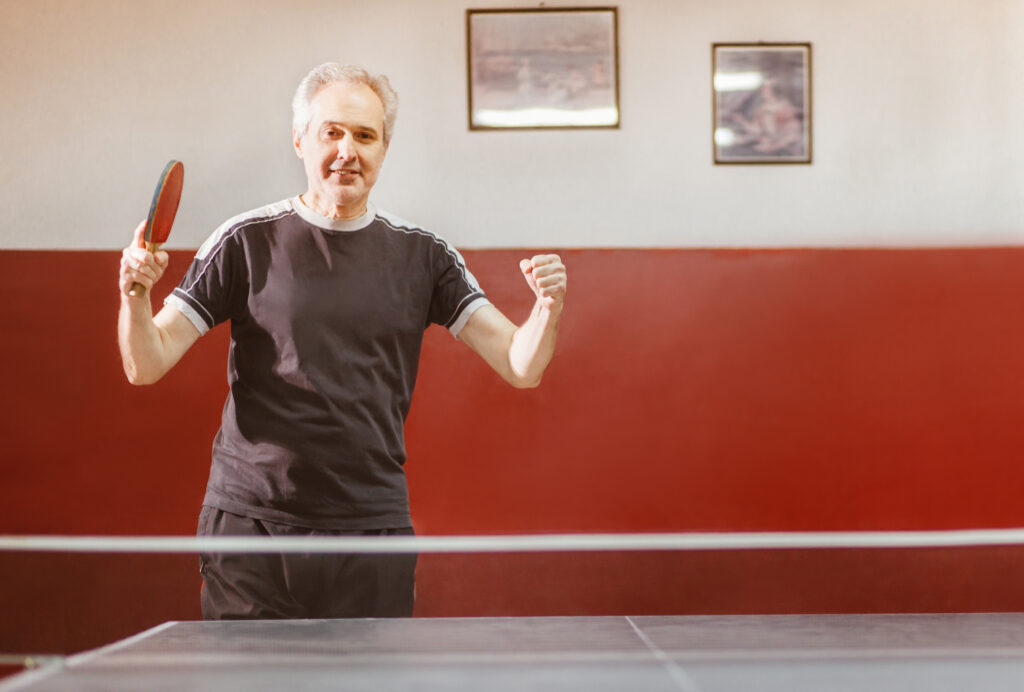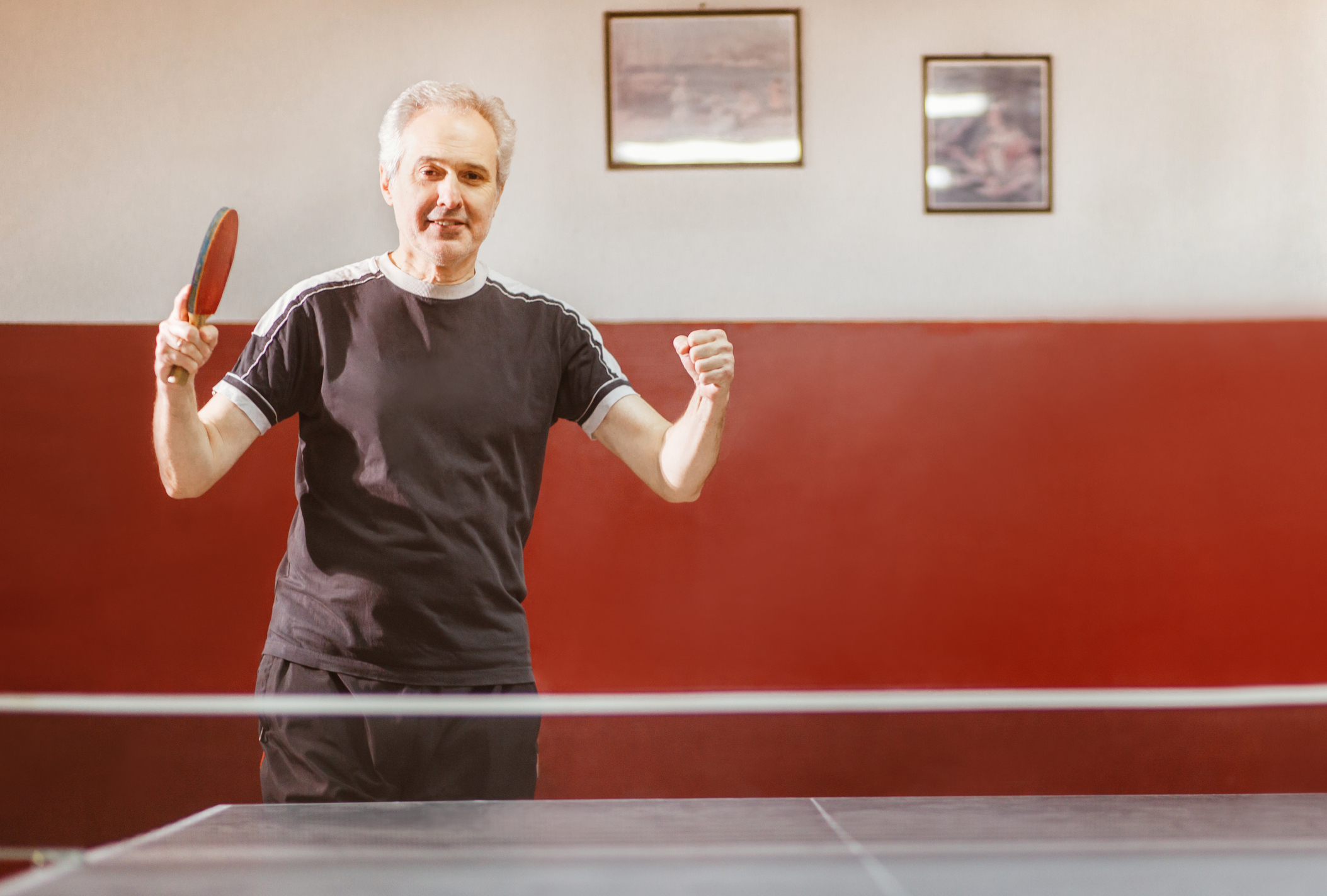
The great thing about table tennis is that you can play competitively – and to a decent standard – in your 60s, 70s and even 80s.
But as we age, some aspects of table tennis become a little more challenging. The most obvious is the physical side of the game. We get a little slower and a little weaker. We have less spring in our step. Maybe our reactions aren’t as sharp. Our eyes don’t see the ball so well. And our knees, hips and back will soon tell us if we have pushed ourselves too hard.
I include myself in this analysis. Next month I will be 41. Whilst I have the youthful looks of a handsome twenty-something (ha!), I can’t ignore the fact that I am officially a ‘veteran’ player. Or in other words, I am old. If I push myself too hard, I feel it. My body aches in ways it didn’t when I was younger.
But getting older, doesn’t mean we have to be any less competitive. And it certainly doesn’t mean we can’t keep on improving. But we may have to adapt the way we play table tennis, so we can reduce the physical stress on our bodies, and still kick some butt!
Here’s three ways you can adapt your game as you get older – to be less physical, but still very competitive – and possibly get a lot better.
1. Improve your backhand
Most players favour their forehand. You can generate more spin, speed and power. But being a forehand dominant player requires more movement. You have to cover more of the table to get your forehand into play. Balls to the forehand side. Balls to the middle. Balls to the backhand side. You can hit them all with your forehand if your footwork is good enough. But you do have to move a lot.
You can make life a lot easier by improving the quality of your backhand. If you develop a reliable backhand push, a reliable backhand block, a reliable backhand drive and a reliable backhand loop, then you don’t need to move anywhere near as much. When the ball comes to the backhand side – or even the middle – then just use your very reliable backhand strokes.
Then the only movement you need is a simple sidestep. You can cover the whole table with one sidestep in one direction and one sidestep in the other direction. Any player, of any age, is capable of doing this for long periods of time, without getting too tired.
Plus if your backhand is as reliable as your forehand, then you have far fewer weak spots. Your overall game is stronger.
2. Stay close to the table
Some older players I coach like to drift back from the table. They do this because they feel they have more time to react to their opponent’s shots. The drawback is that they have to cover more distance when playing back from the table. This requires more physical energy to move to the ball and more physical energy to hit the ball back on the table.
If you play closer to the table, you don’t need to move anywhere near as much. Again, a sidestep in one direction, and a sidestep in another direction and you have the entire table covered. Playing closer to the table also requires less physical energy to play your shots. If you take the ball early you don’t need to play with that much power. A quick push, block or drive reduces the time your opponent has to react. You beat your opponent with speed, rather than physical power.
It may take some practice time to get used to playing closer to the table. But the more you do it, the quicker your reactions become. I remember one older player in the Cambridge league who must have been in his 80s. He could barely move. But he stood close to the table, took everything early and would easily beat players 60 years younger. It’s easier than you may imagine. Give it a go.
3. Shorten your strokes
If you do play closer to the table, you need to shorten your strokes. You don’t have time for big backswings, rotations and follow-throughs.
Try to use short backswings, short rotations and finish all your strokes in front of your body, so you can recover quickly for the next shot.
By shortening your strokes you will be playing with less power, but you will find it easier to contact the ball earlier. So you will still be playing fast table tennis, but you won’t be using that much physical energy.
Short, snappy, fast!
Efficient playing style
Improving your backhand, playing closer to the table and shortening your strokes is a highly efficient and effective way of playing table tennis at the amateur level, without having to physically work too hard.
The older players who stay competitive for the longest – or have continued to improve as they get older – almost always seem to have this playing style. And they don’t seem to break a sweat. Or get injured.
It’s a style of play I am increasingly using as well. I have been looking more to the future – what a 60-year-old Tom will play like – rather than pretending I can emulate the physical explosiveness of a professional player in his twenties.
And I find I have plenty of success when doing this. My backhand is getting stronger all the time. I can win many points by taking the ball early with short strokes. I rush my opponents and force them to make errors or weak shots.
And I can play for hours without getting tired. The best thing? My knees, hips and back don’t ache when I wake up in the morning. I feel I can play this way for the next 50 years!
Improve your tactical game
If you want more tactical tips, I recommend you join Tom’s TT Academy. You will also get access to a wide range of coaching content, including:
- in-depth courses
- training drills
- video analysis
- fitness videos
- robot training videos
- member discussions
- pro match analysis
- skill challenges
- and lot’s more!
You can access all this content for less than £1 per week. New content is added regularly. Join hundreds of table tennis players around the world today at tomsttacademy.com

